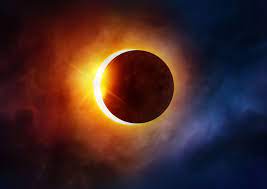Solar eclipses are one of nature’s most spectacular events, captivating observers with the dramatic interplay of celestial bodies. These phenomena occur when the moon passes between the earth and the sun, temporarily obscuring the sun’s light. Understanding the mechanics behind solar eclipses, their predictability, and their impact on culture and science can enhance our appreciation for these rare occurrences. This article delves into the intricacies of solar eclipses, exploring how and when they happen and their significance throughout history.
Key Takeaways
- Solar eclipses occur when the Moon moves between the Earth and the Sun, casting a shadow on Earth and leading to either a total, partial, or annular eclipse.
- The predictability of solar eclipses is based on the Saros cycle, which allows for accurate predictions of when and where eclipses will occur.
- Total solar eclipses are particularly rare and special, with any given location on Earth experiencing one approximately every 400 years.
- Scientific observations during solar eclipses have led to significant discoveries, such as understanding the sun’s corona and advancing astronomical techniques.
- Solar eclipses have had a profound cultural and historical impact, inspiring myths, influencing art and literature, and shaping modern societal perspectives.
The Phenomenon of Solar Eclipses

The Celestial Alignment
A solar eclipse is a captivating celestial event that occurs when the Moon passes between the Earth and the Sun, casting a shadow on the earth’s surface. This alignment is a delicate and precise dance of the cosmos, where the sun, moon, and earth must be in a near-perfect line. The type of solar eclipse we experience on Earth depends on the exact nature of this alignment.
During a total solar eclipse, the moon completely covers the sun, leading to the awe-inspiring moment of totality. However, this phenomenon is not always guaranteed during an eclipse; it is typically because the Sun, Moon, and Earth are not completely lined up that we may witness other types of eclipses, such as partial or annular.
The beauty of a solar eclipse lies in its rarity and the unique conditions required for its occurrence. It’s a reminder of the grand scale of our solar system and the precise mechanics that govern celestial movements.
The following list outlines the types of solar eclipses based on the celestial alignment:
- Total Solar Eclipse: Occurs when the Moon completely obscures the Sun, as viewed from Earth.
- A partial solar eclipse happens when only a part of the sun is obscured by the moon.
- Annular Solar Eclipse: The Moon covers the center of the Sun, leaving a ring-like shape known as the “ring of fire.”
Types of Solar Eclipses
Solar eclipses are a captivating celestial event where the moon passes between the earth and the sun, casting a shadow over our planet. This alignment, known as syzygy, leads to three primary types of solar eclipses: total, partial, and annular. Total solar eclipses occur when the moon completely covers the sun, as viewed from Earth, plunging a narrow area into darkness. During a partial solar eclipse, only a portion of the sun is obscured by the moon. In contrast, an annular eclipse happens when the moon is too far from Earth to completely cover the sun, leaving a bright ‘ring of fire’ visible around the moon’s silhouette.
A less common type is the hybrid eclipse, which shifts between total and annular along different sections of its path. The experience of an eclipse can vary dramatically depending on the observer’s location relative to the moon’s shadow.
- Total Solar Eclipse: The Sun is completely obscured by the Moon.
- Partial Solar Eclipse: Only part of the sun is blocked by the moon.
- Annular Solar Eclipse: The Moon is too far away to fully cover the Sun, creating a ring-like effect.
- Hybrid Eclipse: exhibits characteristics of both total and annular eclipses along its path.
The beauty and rarity of solar eclipses have fascinated humans for millennia, offering a momentary glimpse into the cosmic dance of celestial bodies.
Viewing Solar Eclipses Safely
When a solar eclipse graces our skies, it’s an event that beckons us to look up in awe. However, the importance of viewing a solar eclipse safely cannot be overstated. Directly observing the sun without proper protection can lead to serious and permanent eye damage, including solar retinopathy.
To ensure a safe experience, always use solar viewing glasses or handheld solar viewers that meet the ISO 12312-2 international standard. These viewers are specifically designed to block harmful solar radiation and are many times darker than typical sunglasses, which are not safe for viewing solar eclipses.
Here are the safe methods to view a solar eclipse:
- Solar viewing glasses or handheld solar viewers must comply with the ISO 12312-2 standard.
- Telescopes or binoculars with solar filters: Ensure that solar filters are properly installed before use.
- Pinhole projector: a simple and indirect method to observe the eclipse’s projection.
Remember, it is only during the brief total phase of a total solar eclipse, when the moon completely obscures the sun, that one can safely look directly at the eclipse without any protection. Plan your viewing strategy in advance, and never compromise on the safety of your eyes.
Predicting Solar Eclipses

Understanding Eclipse Cycles
Eclipse cycles are the periods over which eclipses repeat due to the orbital motions of the Earth and Moon. Eclipses are rare because they can only take place when the sun, the earth, and the moon are all aligned. They always happen in groups of two or three, known as eclipse seasons, which occur twice a year.
During an eclipse season, the alignment of the celestial bodies is such that solar eclipses can occur.
The predictability of eclipse cycles is due to the Saros cycle, a period of approximately 18 years and 11 days, after which the Sun, Earth, and Moon return to nearly the same relative geometry. This cycle allows for the prediction of eclipses years in advance. Here is a simplified list of steps to understand how eclipse cycles work:
- Identify the pattern of the moon’s orbit around the earth.
- Recognize the points where the moon’s orbit crosses the earth’s orbital plane (nodes).
- Note that eclipses can only occur when a new moon or full moon happens near these nodes.
- Understand that the Saros cycle leads to a series of eclipses that are similar in nature.
The Role of Saros in Eclipse Predictions
The Saros cycle is a period of approximately 18 years, 11 days, and 8 hours that is crucial for predicting solar eclipses. This cycle is the length of time after which the Earth, Moon, and Sun return to approximately the same relative positions, allowing a similar eclipse to occur. The Saros cycle is instrumental in forecasting when and where solar eclipses will happen, as each cycle leads to a series of eclipses that are similar in nature.
The predictability provided by the Saros cycle is invaluable for both amateur and professional astronomers in planning observations and scientific studies.
Eclipses within a Saros series gradually shift geographically due to the cycle’s additional one-third of a day. This means that after three Saros cycles, or about 54 years, eclipses will recur at roughly the same geographic location. Here’s a simplified breakdown of the Saros cycle’s impact:
- Eclipses recur every 18 years, 11 days, and 8 hours.
- Each Saros series typically lasts 12 to 15 centuries.
- Over 40 Saros series are currently active, producing eclipses.
Understanding the Saros cycle is essential for anyone interested in the patterns and recurrences of solar eclipses.
Upcoming Notable Solar Eclipses
The anticipation for upcoming solar eclipses is always high, especially when they are accessible to large populations. The next total solar eclipse observable in North America will not occur until March 30, 2033, making each event a rare and sought-after spectacle.
For those eager to mark their calendars, here is a brief list of notable solar eclipses in the near future:
- October 14, 2023: An annular ‘ring of fire’ eclipse is visible in parts of the U.S. Southwest and several countries in Latin America.
- April 8, 2024: A total solar eclipse crosses North America, with a path of totality from Mexico through the central U.S. and into Canada.
While solar eclipses happen two to three times each year, the path of totality for total eclipses often passes over less populated areas, making eclipses like the one in 2024 particularly special.
Additional resources for enthusiasts and researchers include detailed maps and predictions available on websites such as NASA’s eclipse website, Eclipse Wise, GreatAmericanEclipse.com, and interactive maps on Xavier Jubier’s eclipse website. Meteorological predictions for the best viewing conditions can be found on eclipsophile.com.
The Rarity and Duration of Solar Eclipses

Why Total Solar Eclipses Are Special
Total solar eclipses captivate observers for their rarity and the unique celestial conditions required for their occurrence. The path of totality, where the sun is entirely obscured by the moon, is remarkably narrow, often spanning just about 100 miles across. This makes witnessing a total eclipse a once-in-a-lifetime event for many people.
Total solar eclipses offer a rare opportunity to view the Sun’s corona, an outer layer that is usually hidden by the bright solar disk. During totality, the corona becomes visible as a glowing halo, providing a spectacular sight and valuable scientific data.
The upcoming 2024 total solar eclipse is particularly noteworthy. Not only will it be the longest totality on land for over a decade, but the duration of totality could be twice as long as the one experienced in 2017, depending on the observer’s location. Here’s a quick overview of the next opportunities to witness this phenomenon in North America:
- April 8, 2024: The next total solar eclipse, with extended totality duration
- After 2024: The subsequent total solar eclipse will not occur for another 20 years
While solar eclipses occur two to three times each year, not all are total, and even fewer traverse densely populated regions. The anticipation for the 2024 event is high, as eclipse enthusiasts and scientists alike prepare to observe and study this extraordinary event.
Factors Influencing Eclipse Frequency and Location
The occurrence of solar eclipses is not random but influenced by a complex interplay of celestial mechanics. The primary factors include the alignment of the Earth, Moon, and Sun, as well as the orbits of these bodies. Solar eclipses happen more frequently than lunar eclipses, with an average of 2–5 solar eclipses occurring each year.
The visibility of an eclipse is highly dependent on one’s location on Earth. To witness the awe-inspiring totality of a solar eclipse, one must be within the narrow path of totality, which is typically less than 150 miles wide. Weather conditions also play a crucial role, as cloud cover or precipitation can obscure the view.
The path of totality is a fleeting opportunity to experience the full spectacle of a solar eclipse, making the choice of location a critical decision for eclipse chasers.
Predicting the exact location and frequency of solar eclipses involves understanding the cycles and patterns that govern their occurrence. Resources such as NASA’s eclipse website and interactive Google Maps by Xavier Jubier provide valuable information for planning observations of future eclipses.
Measuring the Duration of an Eclipse
The duration of a solar eclipse is a captivating aspect of this celestial event. The length of totality can vary significantly, from just a few seconds to over seven minutes, depending on several factors. One key element is the location of the observer within the path of totality; those situated closer to the centerline will experience a longer duration of totality.
The maximum duration of totality occurs at a specific point along the path and diminishes as the moon’s shadow moves away from this point.
To accurately measure the duration of an eclipse, observers can use precise timing equipment or refer to calculations provided by eclipse experts. These calculations take into account the geometry of the Earth, moon, and sun, as well as the observer’s exact location. For instance, during the upcoming April 8, 2024, solar eclipse, the point of longest totality is expected to be near Nazas, Durango, Mexico, where viewers could witness totality for approximately 4 minutes and 28 seconds.
Below is a table showcasing the duration of totality for selected locations during the 2024 solar eclipse:
| Location | Totality Duration |
|---|---|
| Pacific Coast, MX | 4m 27s |
| Nazas, Durango, MX | 4m 28s |
| North America Exit | 2m 52s |
For those curious about whether their location falls within the path of totality, specialized solar eclipse calculators can provide this information.
Scientific Insights from Solar Eclipses

Studying the Solar Corona
During a total solar eclipse, the moon’s intervention allows us to observe the sun’s corona without the need for artificial suppression of the sun’s brilliance. This rare opportunity provides invaluable insights into the outermost layers of the sun’s atmosphere.
The corona, visible as a halo during totality, is a plasma field extending millions of kilometers into space, offering clues about solar winds and space weather phenomena.
Solar eclipses enable researchers to gather unique data sets that are otherwise difficult to obtain. Space missions like the Solar and Heliospheric Observatory contribute detailed observations, but eclipses offer a different perspective, revealing the corona’s shape and streamers that stretch across the sky.
Vocabulary:
- Corona: The sun’s outer atmosphere, visible during a total solar eclipse.
- Penumbra: The region where observers see a partial eclipse, as only part of the sun is obscured.
Eclipses in Historical Science Discoveries
Throughout history, solar eclipses have not only captivated human imagination but have also been pivotal in advancing scientific knowledge. One of the most significant discoveries made during a solar eclipse was the validation of Einstein’s theory of general relativity. During the total solar eclipse of 1919, observations confirmed the bending of starlight around the sun, a phenomenon predicted by the theory.
Solar eclipses have also allowed astronomers to study the sun’s corona, the outermost part of the sun’s atmosphere. Normally invisible, the corona can only be observed during a total solar eclipse, providing unique insights into solar wind and space weather.
Solar eclipses continue to offer invaluable opportunities for scientific research, allowing for observations that are not possible under normal circumstances.
The following list highlights some of the key scientific milestones associated with solar eclipses:
- Confirmation of Einstein’s theory of general relativity (1919)
- Observations of solar prominences and the solar corona
- discovery of helium in the solar spectrum (1868)
- Insights into the mechanics of the sun’s atmosphere
- Advancements in understanding solar wind and its effects on Earth
Modern Technological Advancements and Eclipses
The advent of modern technology has significantly enhanced our understanding and experience of solar eclipses. High-resolution imaging and live streaming have democratized access to these celestial events, allowing people from all corners of the globe to witness the spectacle in real-time, regardless of their location.
Advancements in predictive models have also improved. Websites like NASA’s eclipse page, Eclipse Wise, and GreatAmericanEclipse.com provide detailed forecasts and interactive maps, making it easier for enthusiasts to plan their viewing experiences.
- NASA’s future eclipses page for planning
- Eclipse Wise for predictions and detailed information
- GreatAmericanEclipse.com for maps and resources
The integration of technology in eclipse observation not only enriches the viewing experience but also opens up new avenues for scientific research and public engagement.
Meteorological websites such as eclipsophile.com offer climate and weather predictions, crucial for observers aiming for the best viewing conditions. The collaboration between astronomers, meteorologists, and cartographers exemplifies the interdisciplinary nature of modern eclipse studies.
Cultural and Historical Impact of Solar Eclipses
Myths and Superstitions Around the World
Throughout history, solar eclipses have been steeped in myth and superstition, often evoking awe and fear among various cultures. These celestial events have been interpreted as powerful omens, sometimes signaling divine displeasure or heralding significant change.
- In ancient China, a solar eclipse was believed to be a dragon devouring the sun, prompting loud noises and clamor to scare the creature away.
- The Vikings attributed eclipses to wolves chasing the Sun, while in Vietnam, a frog or toad was thought to be causing the eclipse by swallowing the Sun.
- Many Native American tribes considered the eclipse a time for reflection and reconciliation, with the sun’s disappearance being a period of renewal.
While the scientific understanding of solar eclipses has demystified their occurrence, the cultural significance remains deeply ingrained in the collective memory of societies around the world.
These interpretations have varied widely, but they often share a common thread of recognizing the eclipse as a momentous event, one that could influence the natural order and the fate of people. As we continue to explore the cultural impact of eclipses, it’s clear that they are more than just astronomical phenomena; they are a testament to humanity’s enduring quest to find meaning in the cosmos.
Eclipses in Literature and Art
Solar eclipses have long captivated the human imagination, finding their way into the tapestry of literature and art. Throughout history, these celestial events have symbolized transformation and change, both in personal lives and in the broader strokes of human civilization. Many individuals report profound personal transformations and spiritual insights during solar eclipses. The convergence of celestial bodies and the cosmic shift they represent have inspired countless works, from poetry to paintings.
In literature, eclipses often serve as powerful metaphors for enlightenment or upheaval. They appear in the works of classic authors and modern scribes alike, each interpreting the phenomenon through the lens of their time and culture. Similarly, in the realm of the visual arts, artists have used the dramatic imagery of an eclipsed sun to convey a range of emotions and narratives.
The impact of solar eclipses on creative expression is undeniable. They challenge artists and writers to explore the depths of human experience, reflecting the awe and mystery that these events evoke in all of us.
While the specific pieces and their interpretations are as varied as the artists themselves, a common thread is the profound effect that these cosmic events have on our collective psyche. Below is a list of notable works influenced by solar eclipses:
- Shakespeare’s ‘King Lear’
- Mark Twain’s ‘A Connecticut Yankee in King Arthur’s Court’
- Annie Dillard’s essay ‘Total Eclipse’
- The famous woodcut ‘The Eclipse’ by M.C. Escher
The Influence of Eclipses on Modern Society
Solar eclipses continue to captivate modern society, not only as spectacular celestial events but also as catalysts for scientific curiosity and public engagement with astronomy. The communal experience of a solar eclipse often ignites a widespread interest in the cosmos and its workings.
- I CAN Recognize Cultural Significance: Solar eclipses hold a unique place in the cultural tapestry of societies, intertwining with myths, legends, and contemporary beliefs.
- I can appreciate scientific research opportunities. These events provide unparalleled opportunities for scientific research, from observing animal behavior changes to advancing our understanding of the sun.
Solar eclipses serve as a reminder of our place in the vast universe and the continuous pursuit of knowledge that defines humanity.
The anticipation of solar eclipses also leads to the dissemination of educational resources and the planning of community events. Websites like NASA’s eclipse page, Eclipse Wise, and GreatAmericanEclipse.com become valuable tools for both enthusiasts and educators. The next total solar eclipse is an eagerly anticipated phenomenon, with many already marking their calendars and planning their viewing strategies.
Conclusion
Solar eclipses are a remarkable natural phenomenon that occur when the Moon aligns between the Earth and the Sun, casting a shadow on our planet and temporarily dimming the daylight. While they happen with some regularity, averaging two to five times a year, the rarity of witnessing a total solar eclipse from any given location—often only once every few centuries—makes each occurrence a special event. Understanding the mechanics behind solar eclipses, from the alignment of celestial bodies to the types of shadows cast, enriches the experience of viewing this celestial spectacle. It’s important to remember to always use proper safety equipment, like eclipse glasses or solar filters, to protect your eyesight during these events. As we continue to marvel at the beauty and science behind solar eclipses, we are reminded of the dynamic and ever-changing nature of the cosmos we inhabit.
Frequently Asked Questions
What is a solar eclipse?
A solar eclipse occurs when the moon passes between the earth and the sun, casting a shadow on the earth and either fully or partially obscuring the sun’s light in some areas.
How often do solar eclipses occur?
Solar eclipses happen two to five times a year, with total solar eclipses occurring on average every 18 months. However, for any given location on Earth, total solar eclipses are seen approximately every 400 years.
What are the different types of solar eclipses?
There are three main types of solar eclipses: total, where the Moon completely covers the Sun; partial, where only a part of the Sun is obscured; and annular, where the Moon covers the Sun’s center, leaving a ring-like appearance.
Why are total solar eclipses considered special?
Total solar eclipses are rare and spectacular events that allow observers to see the sun’s outer atmosphere, the corona. They also transform the day into twilight for a brief period, which is a unique experience.
How should one safely view a solar eclipse?
To safely view a solar eclipse, one should use eclipse glasses, solar filters, or indirect viewing methods like a pinhole projector. Directly looking at the sun without proper protection can cause serious eye damage.
What scientific insights have been gained from solar eclipses?
Solar eclipses have provided valuable insights into the sun’s structure, particularly the solar corona. They have also played a role in historical scientific discoveries, such as validating Einstein’s theory of general relativity.








Your article helped me a lot, is there any more related content? Thanks!